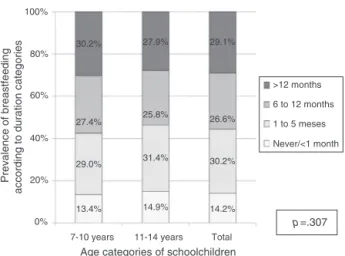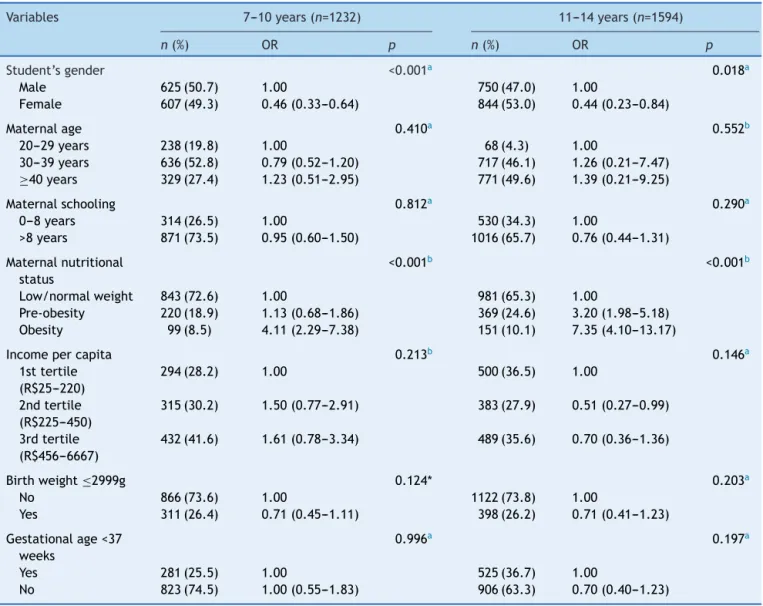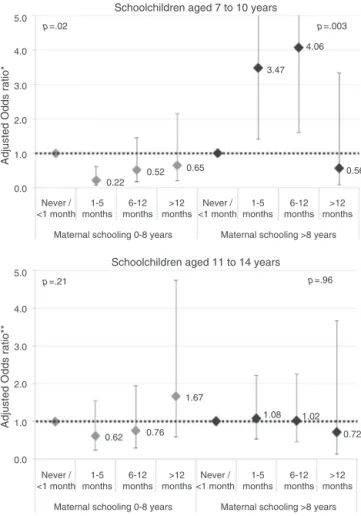www.rpped.com.br
REVISTA
PAULISTA
DE
PEDIATRIA
ORIGINAL
ARTICLE
Effect
of
breastfeeding
on
obesity
of
schoolchildren:
influence
of
maternal
education
Katia
Jakovljevic
Pudla,
David
Alejandro
Gonzaléz-Chica,
Francisco
de
Assis
Guedes
de
Vasconcelos
∗UniversidadeFederaldeSantaCatarina(UFSC),Florianópolis,SC,Brazil
Received30October2014;accepted23January2015
Availableonline29June2015
KEYWORDS
Breastfeeding; Obesity; Schoolchildren
Abstract
Objective: Toevaluatetheassociationbetweendurationofbreastfeeding(BF)andobesityin schoolchildrenofFlorianópolis(SC),andtheroleofpossibleeffectmodifiers.
Methods: Cross-sectional study with arandom sampleof 2826schoolchildren (7---14 years). Weightandheightweremeasuredaccordingtostandardizedprocedures.DataconcerningBF andsociodemographicvariableswereobtainedfromaquestionnairesenttoparents/guardians. Children’snutritionalstatuswasevaluatedbyBMI-for-agez-scoreforgender(WHOreference curves).Adjustedanalyseswereperformedthroughlogisticregression,consideringapossible interactionamongvariables.
Results: Prevalenceofobesitywas 8.6%(95%CI:7.6---9.7%)and55.7% (95%CI:53.8---57.6%) receivedbreastmilkfor≥6months.BFwasnotassociatedwithobesity,evenintheadjusted
analysis.Stratifiedanalysisaccordingtomaternalschoolingshowedthat,inchildrenaged7---10 yearsandchildrenwhosemothershad0---8yearsofschooling,thechanceofobesitywaslower amongthosebreastfeedfor>1month,especiallyamongthosewhoreceivedbreastmilkfor1---5 months(OR=0.22;95%CI0.08---0.62).Amongchildrenofwomenwithhigherschooling(>8years), thechanceofobesitywas44%lowerinthosewhowerebreastfedfor>12months(p-valuefor interaction<0.01).Thisinteractionwasnotfoundinolderchildren(11---14years).
Conclusions: Amongchildrenofwomenwithlowerschooling,BFforanyperiodlongerthan1 monthisprotectiveagainstobesity;however,forahighermaternalschooling,BFforlessthan 12monthsincreasestheoddsofobesity.
© 2015Sociedadede Pediatria de SãoPaulo. Published by Elsevier Editora Ltda.All rights reserved.
DOIoforiginalarticle:http://dx.doi.org/10.1016/j.rpped.2015.01.004 ∗Correspondingauthor.
E-mail:f.vasconcelos@ufsc.br(F.d.A.G.deVasconcelos).
PALAVRAS-CHAVE
Aleitamentomaterno; Obesidade;
Escolares
Efeitodoaleitamentomaternosobreaobesidadeemescolares:influênciada escolaridadedamãe
Resumo
Objetivo: Avaliaraassociac¸ãoentreadurac¸ãodoaleitamentomaterno(AM)eaobesidadeem escolaresdeFlorianópolis(SC),assimcomoopapeldepossíveismodificadoresdeefeito.
Métodos: Estudotransversalcomamostraprobabilísticade2.826escolaresde7---14anos.Foram aferidosopesoeaalturadosescolares,deacordocomprocedimentospadronizados.Dados referentes ao AMe variáveissociodemográficasforamobtidos porquestionárioenviado aos pais/responsáveis.Oestadonutricionalfoiavaliadopeloescore-ZIMC/idade(curvasdaOMS), deacordocomosexo.Análisesajustadasforamfeitascomregressãologísticaefoiconsiderada apossívelinterac¸ãodevariáveis.
Resultados: Aobesidadeafetou8,6%dosescolares(IC95%:7,6---9,7%)eoAMpor≥seismeses
foiencontradoem55,7%(IC95%:53,8%-57,6%).OAMnãoesteveassociadoàobesidade,mesmo nasanálisesajustadas.Asanálisesestratificadasporescolaridadematernamostraramque,nas crianc¸asde7-10anosefilhosdemulherescomatéoitoanosdeestudo,aobesidadefoimenor nosquereceberamAMporqualquerperíodo>1mês,emespecialentreaquelesquereceberam AMpor1-5meses(RO=0,22;IC95%:0,08---0,62).Nosfilhosdemulherescommaiorescolaridade (>8anos),achancedeobesidadefoi44%menornosquehaviamrecebidoleitematernopor>12 meses(pdeinterac¸ão<0,01).Emadolescentesde11---14anosnãofoiverificadaessainterac¸ão.
Conclusões: OAMporperíodosmaioresdoqueummêsemfilhosdemulherescombaixa esco-laridadeprotegecontraaobesidade,masquandoaescolaridadematernaémaior,períodosde AMmenoresde12mesesaumentamaschancesdeobesidade.
© 2015Sociedadede Pediatriade SãoPaulo. Publicado porElsevier Editora Ltda.Todosos direitosreservados.
Introduction
Overthepastfourdecades,therehasbeenanincreaseof at leastfivefoldinthe prevalenceof obesityamong chil-dren andadolescentsaged5---19 yearsof bothgenders,in Brazil.1
Obesity is amultifactorial diseaseassociatedwith sev-eralhealthproblems2.Thereareseveralfactorsassociated withobesity,andbreastfeeding(BF)seemstoprotetagainst thedisease.TheevidencethatBFcanprotectagainst obe-sityseemstoberelatedtothefactthat breastmilkhas a differentcompositionandhormonalresponsecomparedto othermilks,whichmayalsoberelatedtotheadaptationto thedietafterBF.3However,thehypothesisofthisprotective effectremainsunclear.3---10
Fewstudiesonthisassociationhavebeencarriedoutin middle or low-incomecountries,includingBrazil,11,12 par-ticularlyintheagerangeofelementaryschoolstudents.In thiscontext,theaimofthestudywastoevaluatethe asso-ciationbetweendurationofbreastfeeding(BF)andobesity in schoolchildren from Florianópolis,state of Santa Cata-rina, Brazil, and the role of potential effect modifiersin elementaryschoolstudentsinthesamecity.
Method
Cross-sectionalstudywitha randomsampleof schoolchil-dren aged 7---14 years enrolled in public and private elementary schools in Florianópolis (SC). Sample size
calculation and sample selection have been described in apreviouslypublishedarticle.13 Inbrief,itwasconsidered forsample sizecalculationa prevalenceof10% ofobesity in children aged 7---10 years and17% in adolescents aged 11---14 years, witha margin of error of 2%, design effect of1.3andstudypowerof80%.Consideringthesedata,we estimatedthenumberof2800studentstobeassessed. More-over,assumingarandomlossof10%,weobtainedatotalof 3100schoolchildrentobeselected.
The study used a probabilistic sampling design in two phases. In the first phase, local schools were divided into four strata, according to two geographi-cal areas (downtown/continent and beaches) and types of school (public or private). Within each stratum, schools were randomly selected. The sample included 17 schools (11 public and 6 private). In the second phase, in each included school, children were randomly selected.
The study included studentsaged 7---14 yearsthat had the permission of their parents or guardians to partici-pate,bysigningtheinformedconsentform.Thestudywas approvedbytheInstitutionalReviewBoardofUniversidade Federal de Santa Catarina/CCS on24 April 2006 (Opinion 028/06).
The data collection team consisted of 10 trained and standardizedexaminers.Apilotstudywascarriedoutwith anthropometricmeasurementsintwoschoolsof Florianópo-listhatwerenotincludedinthestudysample.14
ofLohman,RocheandMartorell(1988).16 Bodyweightwas measuredusinganelectronicMarte®scalewith180kg
capac-ityandaccuracyof100g,andheightwasmeasuredusingan Alturexata® stadiometer,withaccuracyof onemillimeter.
DatawerecollectedbetweenMarchandDecember2007. Data related to BF and other information used for the control variables were obtained through a ques-tionnaire sent to students’ parents/guardians. Birth and childhood data of the schoolchildren (birth weight, ges-tational age andduration of breastfeeding), demographic data (maternal schooling and age, total monthly income, number of household members) and anthropometric data ofthe schoolchildren’smothers (self-reported weightand height) were collected. The covariate sexual matura-tion was collected only in students aged 11---14 years, througha spreadsheet containing the figures correspond-ingtothesexualmaturationstagesproposedbyTanner17in drawings.
BFdatawereobtainedbasedonthefollowingquestion tothe parents or guardians, ‘‘How long wasthe student breastfed?’’ This question was divided into breastfeeding timecategories,whichwerethengroupedfordataanalysis. Thedatawereprocessedelectronicallyin thesoftware EpiData3.0 andalldata wereverifiedandreceived auto-maticchecksforconsistencyandamplitude.
The schoolchildren’s nutritional status (outcome vari-able)wascategorizedaswithout obesity (≤z-score+2) or
obese(>z-score+2),basedonbodymassindex(BMI)curves forageandgender,accordingtotheWHOreferencecurves (2007).18 For comparative analysis, nutritional status was alsoclassifiedaccordingtotherecommendationofthe Inter-nationalObesityTaskForce(IOTF),accordingtoColeetal.19 Theintentionofthiscomparisonwastoverifywhetherthe associationresults weresimilar,asmostof thestudies on thesubjectusedadifferentclassificationthanthatusedby theWHO(2007).18
The BF(exposurevariable)wasanalyzedin two differ-entways:first,itwascategorizeddichotomouslyas‘‘never receivedbreastmilk/received for <1month’’or ‘‘received for ≥1 month’’; then, it was categorized according to
the duration of breastfeeding, ‘‘never received breast-milk/received breastmilk for <1 month,’’ ‘‘from 1 to 5 months’’,‘‘from6to12months’’and‘‘for>12months.’’
Schoolchildrenagewasclassifiedintotwogroups:7---10 and11---14years,andassociationanalyseswereperformed independently,according to the age group. The variables used aspossible confounding factors were: child gender; maternal age (20---29 years; 30---39 years; ≥40 years)and
schooling (0---8 and >8 years),maternal nutritional status (underweight/normalweight,BMI<25.0kg/m2; pre-obesity,
BMI=25.0---29.9kg/m2, obesity,BMI≥30kg/m2, according to
WHOclassification);15 per capitafamilyincomeintertiles (R$25.00---220.00; R$225.00---450.00; R$446.00---6667.00); birth weight (considered as low/insufficient when birth weight≤2.999g),15 andgestationalageatbirthofthe
stu-dent(premature ifgestationalage<37weeks).Thesexual maturationstagewasusedforthestudentsaged11---14years asacovariatethatmayinfluenceBFassociationswiththe outcome.
AllanalyseswereperformedusingSTATAstatistical soft-ware,release11.0. The bivariate analysis wasperformed
>12 months
6 to 12 months
1 to 5 meses
Never/<1 month 25.8%
27.9% 29.1%
26.6%
30.2% 31.4%
27.4%
29.0%
13.4% 14.9% 14.2%
30.2%
40% 60% 80%
20%
0%
7-10 years 11-14 years Total Age categories of schoolchildren
p=.307
Prevalence of breastfeeding
according to duration categories
Figure 1 Sample distribution according to breastfeeding durationamongschoolchildrenaged7---14years.Florianópolis, SC,2007.
usingthechi-squaretestforheterogeneityortrend, accord-ing to the nature of the independent variables. Logistic regressionwasusedforthemultivariateanalysis,inwhich the variables wereincluded and maintainedin the analy-ses by backwardselection, according to hierarchylevels. Variables withp<0.20 in the adjusted analysis were kept inthemodelaspotentialconfounders.Interactionanalyses werealsoperformed,inwhichthevariablespercapita fam-ilyincome, maternalschoolingandnutritionalstatuswere tested aspotentialeffectmodifiersof theBFand obesity association.
The SVY command of STATA was used in all analy-ses toconsider thesampling effect.All regression results are shown as Odds Ratio (OR) with their respective 95% confidenceintervals(95%CI),consideringvariableswith sta-tisticalsignificancethosewithp<0.05.
Results
Of the 3100 students selected for the study, data on 2863 individuals were obtained. Of these, 37 students were excluded because they were aged <7 or >14 years, adding up 2826 participants (91.2%), which was in accor-dance with the minimum calculated sample size (2800 students).
Thefinalstudysampleconsistedof1232schoolchildren aged 7---10 years and 1594 aged 11---14 years. The over-all prevalence of obesity was10.5% among children aged 7---10years(95%CI:8.0---12.3%)and6.7%(95%CI:5.7---8.3%) amongchildrenaged11---14 years(p<0.001).RegardingBF,
Fig. 1 shows that 44.4% of children were breastfed for less than 6 months, and less than a third was breast-fedfor more than12 months.There wasnodifferencein theprevalence of BFwhen comparingthetwoagegroups (p=0.307).
Table1 Crude OddsRatio(OR)forobesityaccordingtocharacteristicsofthestudentsaged7---14years,their mothersand families.Florianópolis,SC,2007.
Variables 7---10years(n=1232) 11---14years(n=1594)
n(%) OR p n(%) OR p
Student’sgender <0.001a 0.018a
Male 625(50.7) 1.00 750(47.0) 1.00
Female 607(49.3) 0.46(0.33---0.64) 844(53.0) 0.44(0.23---0.84)
Maternalage 0.410a 0.552b
20---29years 238(19.8) 1.00 68(4.3) 1.00
30---39years 636(52.8) 0.79(0.52---1.20) 717(46.1) 1.26(0.21---7.47)
≥40years 329(27.4) 1.23(0.51---2.95) 771(49.6) 1.39(0.21---9.25)
Maternalschooling 0.812a 0.290a
0---8years 314(26.5) 1.00 530(34.3) 1.00
>8years 871(73.5) 0.95(0.60---1.50) 1016(65.7) 0.76(0.44---1.31)
Maternalnutritional
status
<0.001b <0.001b
Low/normalweight 843(72.6) 1.00 981(65.3) 1.00
Pre-obesity 220(18.9) 1.13(0.68---1.86) 369(24.6) 3.20(1.98---5.18)
Obesity 99(8.5) 4.11(2.29---7.38) 151(10.1) 7.35(4.10---13.17)
Incomepercapita 0.213b 0.146a
1sttertile
(R$25---220)
294(28.2) 1.00 500(36.5) 1.00
2ndtertile
(R$225---450)
315(30.2) 1.50(0.77---2.91) 383(27.9) 0.51(0.27---0.99)
3rdtertile
(R$456---6667)
432(41.6) 1.61(0.78---3.34) 489(35.6) 0.70(0.36---1.36)
Birthweight≤2999g 0.124* 0.203a
No 866(73.6) 1.00 1122(73.8) 1.00
Yes 311(26.4) 0.71(0.45---1.11) 398(26.2) 0.71(0.41---1.23)
Gestationalage<37
weeks
0.996a 0.197a
Yes 281(25.5) 1.00 525(36.7) 1.00
No 823(74.5) 1.00(0.55---1.83) 906(63.3) 0.70(0.40---1.23)
OR,OddsRatio. a Heterogeneitytest. b Lineartendencytest.
The prevalence of obesity in this age group was 13.9% in boys (95% CI: 11.3---16.9%) and 6.9% in girls (95% CI: 5.0---9.2%)(p<0.001).Amongstudentsaged11---14years,53% werefemale,andtheprevalenceofobesitywas9.3%(95% CI:7.3---11.6%) in malesversus 4.3% (95%CI: 3.1---6.0%)in females(p=0.018).
Asforthemothersoftheschoolchildrenaged7---10years, mostwereagedbetween30---39years(52.8%),andamong themothers ofthoseaged11---14 years,40years orolder (49.6%).Regardingmaternalschooling,mosthadmorethan 8 years of schooling (69.6%). Maternal age and schooling werenotassociatedwiththeprevalenceofobesityinboth agegroups.Theprevalenceofmaternalobesitywas9.3%in thetotalsample,andthisvariableincreasedbyatleastfour times the odds of obesity among schoolchildren (p<0.001 in both age groups). Regarding per capita familyincome, amongschoolchildrenaged7---10years,theoddsofobesity
washigher inhighermonthly income, butthis association didnotreachstatisticalsignificance(p=0.213).
Regardingthebirthvariables,mostoftheschoolchildren wasbornweighing≥3000g(73.7%)andwerenotpremature
(68.9%).Neithervariablewasassociatedwithobesityinthe schoolchildren.
According to Table 2, the prevalence of obesity in schoolchildren was not associated with duration of BF in any of the age groups, neither in the crude analysis nor afteradjustmentforpossibleconfoundingfactors.Thesame effectwasobservedwhenBFwastreatedasadichotomous orpolytomousvariable.Nonetheless,amongchildrenaged 7---10years,BFindicatedagreaterchanceofobesity,while amongthoseaged11---14yearstheassociationwasa protec-tiveone.
categories,stratifiedbyage.Florianópolis,SC,2007.
Variable % CrudeOR p-value AdjustedOR p-value
7---10years
Maternalbreastfeeding 0.308 0.320
-Never/<1month 8.1 1.00 1.00a
-≥1month 10.9 1.39(0.71---2.75) 1.48(0.65---3.39)
Breastfeedingduration 0.130 0.228
-Never/<1month 8.1 1.00 1.00a
-1to5months 10.0 1.26(0.62---2.56) 1.39(0.58---3.35)
-6to12months 13.3 1.75(0.89---3.43) 1.80(0.81---4.05)
->12months 8.3 1.03(0.33---3.17) 0.87(0.23---3.25)
11---14years
Maternalbreastfeeding 0.370 0.436
-Never/<1month 8.2 1.00 1.00b
-≥1month 6.4 0.77(0.41---1.43) 0.85(0.55---1.32)
Breastfeedingduration 0.504 0.451
-Never/<1month 8.2 1.00 1.00b
-1---5months 5.7 0.67(0.37---1.23) 0.80(0.49---1.30)
-6---12months 6.9 0.83(0.36---1.89) 0.82(0.43---1.55)
->12months 9.5 1.12(0.58---2.37) 1.30(0.76---2.21)
aAdjustedforgender,mother’snutritionalstatusandbirthweight.
b Adjustedforgender,mother’snutritionalstatus,maternaleducation,gestationalageatbirthandsexualmaturation.
7---10 years. The interaction was observed with both the dichotomousandpolytomousexposure(interaction p<0.01 forboth analyses).Among schoolchildrenaged7---10 years withmothers with less schooling (0---8 years), BFfor any lengthoftime≥1monthwasaprotectivefactorforobesity
whencomparedtothosewhowerebreastfedforlessthan amonthorneverreceivedit(OR=0.37;95%CI:0.15---0.94). Inthe case of the children of women withhigher school-ing(>8years),whentheBFwasevaluatedasadichotomous variable,it wasassociatedwithhigherchancesof obesity (OR=3.43;95%CI:1.49---7.88).WhenassessingBFas polyto-mousvariable(Fig.2),thechanceofobesitywas78%lower (OR=0.22;95%CI:0.08---0.62)amongchildrenofwomenwith lessschoolingwhowerebreastfedfor1---5months,butthe protective effectwas also evident withlonger periods of BF(p=0.02)(Fig.2).Among childrenofwomen withmore schooling,childrenbreastfedformorethan12monthshad aloweroddsofobesity(OR=0.56;95%CI:0.09---3.33),while children who were breastfed for periods of 1---12 months showed a four-fold higher probability than the reference category(p=0.003).Intheagegroupof11---14years,no sta-tistical association wasfound between breastfeeding and obesity,regardlessofmaternalschooling(interactionp>0.2 withthetwoexposurevariables).
Interaction analyses were also performed with the variable per capita income and maternal nutritional sta-tus; however, no effect modification was observed (data not shown). All analyses were repeated using obesity classified according to the criteria of the International Obesity Task Force (IOTF) as outcome,19 which yielded similar results to those previously described (data not shown).
Discussion
Inthepresentstudy,theprevalenceofobesityinthe sam-plewas8.6%,being10.5%amongschoolchildrenaged7---10 years and 6.7% in the age group of 11---14 years. These findingscorroboratethosebytheHouseholdBudgetSurvey (HBS)2008/2009,1 in whichobesitywashigherin children aged7---10 yearsand loweramongadolescents.The over-allprevalenceofobesityfoundbytheHBS,consideringthe age groupof5---19 years,was9.6%, similartothepresent study.1
RegardingtheprevalenceofBF,inthisstudy55.7%ofthe sample wasbreastfedfor 6monthsormore,and29.1% of thesamplewasbreastfedformorethan12months. Consid-eringthattheWHOrecommendsthatbreastfeedingshould bemaintainedupto2yearsofageor older,20 those dura-tions arebelowwhatis recommended.The prevalence of BF in Florianópolis, in spite of the BF distinct methodol-ogy,wassimilartothatfoundinanational-basedpopulation study,whichinvestigatedallBraziliancapitalsandthe Fed-eralDistrictandfoundthat52.2%ofchildrenbetween9and 12 monthsfrom Florianópoliswere breastfed,thehighest prevalenceamongthecapitalsofsouthernBrazil.21
The choice of BF or not and itsduration is related to severalfactors;studieshave shownthatalongerduration of BFis directly associatedwithmaternal age andfamily income.22---24Neitherofthesevariableswasassociatedwith BFdurationinthisstudy.
5.0 4.0 3.0 2.0 1.0 0.0 5.0 4.0 3.0 2.0 1.0 0.0 p=.21 Never / <1 month Never / <1 month 1-5 months 6-12 months >12 months 1-5 months 6-12 months >12 months 0.65 0.56 0.52 0.22
Maternal schooling 0-8 years Maternal schooling >8 years
Never / <1 month Never / <1 month 1-5 months 6-12 months >12 months 1-5 months 6-12 months >12 months
Maternal schooling 0-8 years Maternal schooling >8 years Schoolchildren aged 11 to 14 years
p=.96
0.62 0.76 1.67
1.08 1.02
0.72
Adjusted Odds ratio**
p=.02
3.47 4.06 Schoolchildren aged 7 to 10 years
p=.003
Adjusted Odds ratio*
Figure 2 Association between maternal breastfeeding and obesityaccordingtobreastfeedingdurationcategories, strat-ifiedby age andmaternal schooling. Florianópolis,SC, 2007. * Adjusted for gender, maternal nutritional status and birth weight. ** Adjusted for gender, maternal nutritional status, maternaleducation, gestationalageatbirthandsexual mat-uration.
questionnaires are reliable tools and applicable for the self-reporting of experiences related to breastfeeding, regardlessoftimeofdataquestioning,andcan,therefore, beusedinthistypeofstudy.3,25
BFin thisstudy wasnotassociatedwithobesity in the crudeandadjustedanalyses,andthiseffectwasalso main-tainedwhenusingtheclassificationbyColeetal.19However, when verifying the interaction of the maternal schooling variable in this association, it wasobserved that, among schoolchildren aged 7---10 years, the odds of obesity in children ofwomen withless schoolingwaslowerin those breastfedforamonthormore.Inchildrenofwomenhigher schooling,theprotective effectwasevidentonlyin those whoreceivedbreastmilkformorethan12months,whereas intermediateperiodsofBFwereassociatedwithhigherodds ofobesity.
Several systematic reviews have been carried out regarding this association; among them, Arenz et al.26 showedasmall,butconsistenteffectofBFagainsttherisk ofobesityinlaterchildhood(OR=0.78;95%CI:0.71---0.85). TheWHO3alsoperformedasystematicreviewinwhich,in additiontothisstudy,25threeothersystematicreviewsand
twomorestudieswereanalyzed.The resultofthereview indicatesasmall,butprotectiveeffectofBFregardingthe prevalenceofobesity.
Nevertheless,the literatureshowscontroversial results for this association: some studies found null results,7,8 while others demonstrate that the type and duration of BF protect against obesity.4,5 Among the reasons for the discordant results found in the literature is the hetero-geneityofthe studies, withdifferencesin the ageof the individuals,the researchsite, andthe criteriafor BFand obesityassessment.6 Mostof thestudies werecarriedout in North America and Western Europe,3 with few stud-iesbeing performed in lower-income countries, including Brazil---in fact, there are few studies comparing results fromhigh-income countries with results fromBrazil. The research performed by Brion et al.12 with cohorts from the UK and Brazil (Pelotas city --- RS), with samples aged 9and11 years,respectively, found an inverse association betweendurationofBFandBMIonlyintheEuropeancohort (ˇ=−0.16; 95%CI:−0.22,−0.09).In Pelotas,however, in
additionto not finding an association, there wasa trend ofBFassociationwithhigherBMI(ˇ=0.14;95% CI:−0.07;
0.36).
Inareviewofstudiespublishedfrom2005to2012, Lefeb-vreandJohn10concludedthatthisassociationisstillunclear, especiallyduetothefactthatseveralconfoundingfactors mayinfluencethisassociation.
In the present study, we tried to adjust the analyses considering the main control variables in the association between BFand obesity,among which aresocioeconomic anddemographicfactorsandmaternalvariables.3 Neverthe-less,theassociationsbecameevidentonly whenmaternal schoolingwasintroducedintheanalysesasaneffect modi-fier.Theliteratureshowsalowerchance,aswellassimilar chance of obesity, according tothe BF duration.4,7 There have been studies that even indicate a trend of lower chance of obesity as the duration of BF increases, with a dose---response effect in this association,4 a fact that was not observed in this investigation. Moreover, the BF dose---responseeffectonobesityismoreevidentfor exclu-sivebreastfeeding.The literature indicatesthat exclusive BF,whenmaintainedforalongerperiodoftime,protects childrenandadolescentsfromexcessweight,asthe compo-sition of breast milk contributes to adequate growth.5,27 However, the exclusive BF variable was not measured in this study, and it was not possible to discuss the differ-encesbetweenthetypeofbreastfeedinganditsinfluence onexcessweight.
Thehigheroddsofobesityamongchildrenofwomenwith more schooling who stopped breastfeeding before reach-ing 12 months could be related to the introduction of other types of milk and/or foods with high energy den-sity.Thishypothesisisreasonable,consideringtheincrease in the consumption of processed foods by the Brazilian population,28 which could be influencing children’s diets afterweaning.However,thisinformationwasnotcollected inthisstudy.
in which the prevalence and associations may have been differentduetoacohorteffect.InBrazil,theBFincentive policiesstartedinthe1990s,andtherewasanincreasein themedianbreastfeedingtimebetweentheperiodof1993 and2004.29,30 Thus,thisdifferencein theschoolchildren’s birthperiodwouldbealimitationintheanalysisandcould alsoexplaintheeffect modificationbetween thetwoage groups.
In conclusion, we emphasize that there is satisfactory evidenceoftheseveralBFbenefits,whichshouldbe encour-agedfor the period recommendedby the WHO.3 We also emphasizethatstudiesaimingtoinvestigatetheeffectsof BFonthenutritionalstatusofchildrenandadolescentsneed toconsiderintheirmethodologynotonlythecontrolof con-foundingfactors,butalsothepossibleeffectmodificationby socioeconomicvariables.Furtherstudiesshouldbecarried out toassess this association, especially in lower-income countries,inadditiontotheimplementationofprospective studies that will allow making a more precise inference, analyzing the association between obesity and exclusive breastfeeding,withtheageofintroductionofotherfoods.
Funding
Conselho Nacional de Desenvolvimento Científico e Tecnológico (CNPq) --- Process n. 402322/2005-3-Edict MCT/CNPq/MS-SCTIE-DECIT/SAS-DAB51/2005.
Conflicts
of
interest
Theauthorsdeclarenoconflictsofinterest.
References
1.Brasil---InstitutoBrasileirodeGeografiaeEstatística.Ministério doPlanejamento,Orc¸amentoeGestão.PesquisadeOrc¸amentos Familiares2008---2009---Antropometriaeestadonutricionalde crianc¸as,adolescenteseadultosnoBrasil.RiodeJaneiro:IBGE; 2010.
2.WorldHealthOrganization.Obesity:preventingandmanaging theglobalepidemic.Geneva:WHO;2000.
3.WorldHealthOrganization.Evidenceofthelong-termeffectsof breastfeeding:systematicreviewandmeta-analyses.Geneva: WHO;2007.
4.LieseAD,HirschT,vonMutiusE,KeilU,LeupoldW, Weiland SK.Inverseassociationofoverweightandbreastfeedingin9 to10-y-oldchildreninGermany.IntJObesRelatMetabDisord. 2001;25:1644---50.
5.ToschkeAM,Vignerova J,LhotskaL,OsancovaK,KoletzkoB, VonKriesR.Overweightandobesityin6-to14-year-oldCzech childrenin1991:protectiveeffectofbreast-feeding.JPediatr. 2002;141:764---9.
6.Owen CG, Martin RM, Whincup PH, Smith GD, Cook DG. Effect ofinfantfeedingontheriskofobesity acrossthelife course:aquantitativereviewofpublishedevidence.Pediatrics. 2005;115:1367---77.
7.SabanayagamC,ShankarA,ChongYS,WongTY,SawSM. Breast-feedingand overweightinSingaporeschoolchildren.Pediatr Int.2009;51:650---6.
8.FerreiraRJ,Marques-VidalPM.Prevalenceanddeterminantsof obesityinchildreninpublicschoolsofSintra,Portugal.Obesity (SilverSpring).2008;16:497---500.
MW, Cook DG. The effect of breastfeeding on mean body mass index throughout life: a quantitative review of pub-lishedandunpublishedobservationalevidence.AmJClinNutr. 2005;82:1298---307.
10.LefebvreCM,JohnRM.Theeffectofbreastfeedingonchildhood overweightandobesity:asystematicreviewoftheliterature. JAmAcadNursePract.2014;26:386---401.
11.ScanferladeSiqueiraR,MonteiroCA.Breastfeedingand obe-sityinschool-agechildrenfromfamiliesofhighsocioeconomic status.RevSaudePublica.2007;41:5---12.
12.Brion MJ, Lawlor DA, Matijasevich A, Horta B, Anselmi L, AraujoCL,etal.Whatarethecausaleffectsofbreastfeeding on IQ, obesity and blood pressure? Evidence from compar-inghigh-incomewithmiddle-incomecohorts.IntJEpidemiol. 2011;40:670---80.
13.BernardoCO,VasconcelosFA.Associationofparents’nutritional status, and sociodemographicand dietary factors with over-weight/obesityinschoolchildren7to14yearsold.CadSaude Publica.2012;28:291---304.
14.Frainer DE, Adami F, Vasconcelos F, de A, Assis MA, Calvo MC,KerpelR.Standardizationandreliabilityof anthropomet-ricmeasurementsforpopulationsurveys.ArchLatinoamNutr. 2007;57:335---42.
15.WorldHealthOrganization.Physicalstatus:theuseand inter-pretationofanthropometry.Geneva:WHO;1995.
16.LohmanTG,RocheAF,MartorellR.Anthropometric standard-izationreferencemanual.Champaign:HumanKineticsBooks; 1988.
17.MalinaRM,BouchardC.Growth,maturation,andphysical activ-ity.Champaign:HumanKineticsBooks;1991.
18.DeOnisM,OnyangoAW,BorghiE,SiyamA,NishidaC,Siekmann J.Development ofa WHO growthreference for school-aged childrenand adolescents.Bull WorldHealth Organ.2007;85: 660---7.
19.Cole TJ, Bellizzi MC, Flegal KM, Dietz WH. Establishing a standarddefinitionforchildoverweightandobesityworldwide: internationalsurvey.BMJ.2000;320:1240---3.
20.World Health Organization. Infant and young child feeding: modelchapter fortextbooks for medicalstudents and allied healthprofessionals.Geneva:WHO;2009.
21.Brasil ---Ministério da Saúde.Secretaria deAtenc¸ão à Saúde --- Departamento de Ac¸ões Programáticas e Estratégicas. In: IIPesquisade prevalênciade aleitamentomaternonas capi-taisbrasileiraseDistritoFederal.Brasília:MinistériodaSaúde; 2009.
22.Al-AkourNA, Khassawneh MY,Khader YS,Ababneh AA, Had-dadAM.FactorsaffectingintentiontobreastfeedamongSyrian andJordanianmothers:acomparativecross-sectionalstudy.Int BreastfeedJ.2010;5:6.
23.DennisCL,GagnonA,VanHulst A,DoughertyG, WahoushO. Prediction of duration of breastfeeding among migrant and Canadian-born women: results from a multi-center study. J Pediatr.2013;162:72---9.
24.Kimani-MurageEW,MadiseNJ,FotsoJC,KyobutungiC,Mutua MK,GitauTM,etal.Patternsanddeterminantsofbreastfeeding andcomplementaryfeedingpracticesinurbaninformal settle-ments,NairobiKenya.BMCPublicHealth.2011;11:396. 25.Li R, Scanlon KS, Serdula MK. The validity and
reliabil-ity of maternal recall of breastfeeding practice. Nutr Rev. 2005;63:103---10.
26.ArenzS,RückerlR,KoletzkoB,vonKriesR.Breast-feedingand childhoodobesity---asystematicreview.IntJObesRelatMetab Disord.2004;28:1247---56.
28.Brasil --- Instituto Brasileiro de Geografia eEstatística. Min-istériodoPlanejamento, Orc¸amentoeGestão--- Pesquisade orc¸amentosfamiliares2008---2009---aquisic¸ãoalimentar domi-ciliarpercapita.RiodeJaneiro:IBGE;2010.
29.Gonzalez-Chica DA, Gonc¸alves H, Nazmi A, Santos IS, Bar-rosAJD, MatijasevichA, et al. Seasonality ofinfant feeding
practices in three Brazilian birth cohorts. Int J Epidemiol. 2012;41:743---52.


